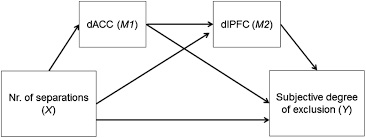These days, few I/O Psychology and Business journals allow the Baron and Kenny method to test for mediation. Instead, a host of other methods are currently applied, and many of them are outlined by MacKinnon, Fairchild, and Fritz (2007), Hayes (2009), or several other articles by these authors. Most of these articles tend to focus on simple mediation, which is demonstrated in the figure below.
 In testing for mediation, one of the most popular methods is the sobel test. The sobel test, for simple mediation, takes the effect size and standard error of X->M and M->Y to calculate the significance of the indirect effect of X on Y through M. If the sobel test is significant, then mediation is supported. Fortunately, if you have the betas and standard errors of the effects, which is provided in regression equations (for example), then a sobel test is extremely easy to perform. So easy, in fact, that several statisticians have created online sobel test calculators. My favorite is here, and it uses the following formula to calculate the sobel test statistic (which is a z-value):
In testing for mediation, one of the most popular methods is the sobel test. The sobel test, for simple mediation, takes the effect size and standard error of X->M and M->Y to calculate the significance of the indirect effect of X on Y through M. If the sobel test is significant, then mediation is supported. Fortunately, if you have the betas and standard errors of the effects, which is provided in regression equations (for example), then a sobel test is extremely easy to perform. So easy, in fact, that several statisticians have created online sobel test calculators. My favorite is here, and it uses the following formula to calculate the sobel test statistic (which is a z-value):
z-value = a*b / SQRT(b2*SEa2 + a2*SEb2)
whereas a is the X->M effect, b is the M->Y effect, SEa is the standard error of a, and SEb is the standard error of b. Not too bad, right? Once we have the z-value, we can enter it into a z- to p-value calculator to determine its significance, but most sobel test calculators will do that for us.
Today, however, I had a little problem. I wanted to calculate the significance of the indirect effect in a serial mediation / sequential mediation, which I will only call serial mediation henceforth. Serial mediation is demonstrated in the figure below.
 Probably the best method to calculate the indirect effect of X on Y in this model is Hayes’s PROCESS macro for SPSS. It automatically calculates the the indirect of X on Y through M1, M2, and both M1 and M2. Then, after providing all three, it calculates their cumulative effects together. It is quite the powerful tool, and I HIGHLY suggest that every psychology or business researcher should learn how to use it.
Probably the best method to calculate the indirect effect of X on Y in this model is Hayes’s PROCESS macro for SPSS. It automatically calculates the the indirect of X on Y through M1, M2, and both M1 and M2. Then, after providing all three, it calculates their cumulative effects together. It is quite the powerful tool, and I HIGHLY suggest that every psychology or business researcher should learn how to use it.
Anyways, for a reason which is a whole ‘nother story, I wanted to calculate the indirect effect of X on Y through M1 and M2, alone, while not using Hayes’s PROCESS macro. So, how do you do that?
Finding the answer was much harder than I expected. I searched for awhile, and SO many resources completely skipped the method they used to calculate their indirect effects. Finally, I came across the answer in Hayes’s (who else) 2013 mediation book who cites Taylor, MacKinnon, and Tein (2008) for providing it. To calculate the indirect effect of X on Y through M1 and M2, the following formula can be used:
z-value = a*b*c / SQRT(a2b2*SEc2 + a2c2*SEb2 + b2c2*SEa2)
whereas a is the X->M1 effect, b is the M1->M2 effect, c is the M2->Y effect, SEa is the standard error of a, and SEb is the standard error of b, and SEc is the standard error of c. Once we have the z-value, we can put it into a z- to p-value calculator and determine its significance.
Once again, not too bad, right? It was for me. I took way too long to find this formula. Then, in the end, it turns out that I just put my model into AMOS to create a structural equation model (SEM) which provides estimates of all indirect effects anyways. So, I spent all that time for nothing. To prevent future researchers from searching too long for the formula for the indirect effect of X on Y through M1 and M2, I am providing it here.
Also, one last note. When calculating the indirect effect of X on Y in serial mediation, you should calculate the indirect effect through M1, M2, and both M1 and M2. Then, their cumulative effects should be combined. Once again, to do this, Hayes’s PROCESS macro in SPSS can be used. But, in special circumstances, you can use the formula above to only calculate the z-value for the indirect effect of X on Y through M1 and M2.
Like always, comment or send me an email at MHoward@SouthAlabama.edu if you have any questions. Be sure to like this page if it helped you!
UPDATE: I created a sobel test calculator for serial mediation. The link is here.

Thank you so much!
LikeLike
That’s right. SEM automatically calculated the indirect effects except for probability. Sobel test allows me to know that…
LikeLike